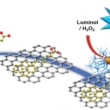댓글 쓰기 권한이 없습니다. 로그인 하시겠습니까?
Spontaneous Pt Deposition on Defective Surfaces of In2O3 Nanocrystals Confined within Cavities of Hollow Silica Nanoshells: Pt Catalyst-?Modified ITO Electrode with Enhanced ECL Performance
| Journal | ACS Appl. Mater. Interfaces |
|---|---|
| Author | Young Shin Cho, Soo Min Kim, Youngwon Ju, Junghoon Kim, Ki-Wan Jeon, Seung Hwan Cho, Joohoon Kim, and In Su Lee |
| Citation | ACS Appl. Mater. Interfaces 2017, 9, 24, 20728?20737 |
| DOI | https://doi.org/10.1021/acsami.7b02757 |

Although the deposition of metallic domains on a preformed semiconductor nanocrystal provides an effective pathway to access diverse hybrid nanocrystals with synergistic metal/semiconductor heterojunction interface, those reactions that take place on the surface of semiconductor nanoscrystals have not been investigated thoroughly, because of the impediments caused by the surface-capping organic surfactants. By exploiting the interfacial reactions occurring between the solution and nanoparticles confined with the cavities of hollow nanoparticles, we propose a novel nanospace-confined strategy for assessing the innate reactivity of surfaces of inorganic semiconductor nanoparticles. This strategy was adopted to investigate the newly discovered process of spontaneous Pt deposition on In2O3 nanocrystals. Through an in-depth examination involving varying key reaction parameters, the Pt deposition process was identified to be templated by the defective In2O3 surface via a unique redox process involving the oxygen vacancies in the In2O3 lattice, whose density can be controlled by high-temperature annealing. The product of the Pt-deposition reaction inside the hollow silica nanoparticle, bearing In2O3-supported Pt catalysts inside the cavity protected by a porous silica shell, was proved to be an effective nanoreactor system which selectively and sustainably catalyzed the reduction reaction of small-sized aromatic nitro-compounds. Moreover, the surfactant-free and electroless Pt deposition protocol, which was devised based on the surface chemistry of the In2O3 nanoparticles, was successfully employed to fabricate Pt-catalyst-modified ITO electrodes with enhanced electrogenerated chemiluminescece (ECL) performance.
-
Read More

Tailoring chemically converted graphenes using a water-soluble pyrene derivative with a zwitterionic arm for sensitive electrochemiluminescence-based analyses
Category2017 AuthorJihye Kwon, Seo Kyoung Park, Yongwoon Lee, Je Seung Lee and Joohoon Kim JournalBiosensors and Bioelectronics CitationBiosensors and Bioelectronics 87 2017 89?95
-
Read More

Tunability of the Adsorbate Binding on Bimetallic Alloy Nanoparticles for the Optimization of Catalytic Hydrogenation
Category2017 AuthorLong Luo, Zhiyao Duan, Hao Li, Joohoon Kim, Graeme Henkelman, and Richard M. Crooks JournalJ. Am. Chem. Soc. CitationJ. Am. Chem. Soc., 2017, 139 (15), pp 5538?5546
-
Read More

Electrochemiluminescence of Water-Soluble Poly(amidoamine) Dendrimers Conjugated with Multiple Ru(II) Tris(bipyridine) Moieties
Category2017 AuthorHyein Lee, Joohoon Kim JournalChemElectroChem CitationChemElectroChem, 2017, 4, 1790
-
Read More

Spontaneous Pt Deposition on Defective Surfaces of In2O3 Nanocrystals Confined within Cavities of Hollow Silica Nanoshells: Pt Catalyst-?Modified ITO Electrode with Enhanced ECL Performance
Category2017 AuthorYoung Shin Cho, Soo Min Kim, Youngwon Ju, Junghoon Kim, Ki-Wan Jeon, Seung Hwan Cho, Joohoon Kim, and In Su Lee JournalACS Appl. Mater. Interfaces CitationACS Appl. Mater. Interfaces 2017, 9, 24, 20728?20737
Designed by sketchbooks.co.kr / sketchbook5 board skin
Sketchbook5, 스케치북5
Sketchbook5, 스케치북5
Sketchbook5, 스케치북5
Sketchbook5, 스케치북5
.png)


 Electrochemiluminescence of Water-Soluble Poly(amidoami...
Electrochemiluminescence of Water-Soluble Poly(amidoami...